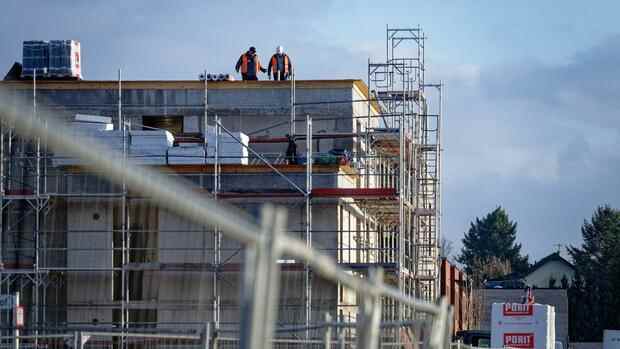Scaffolded, unfinished new buildings in North Rhine-Westphalia. The government wants to create 400,000 new homes annually.
Photo: dpa
(Photo: dpa)
Frankfurt Despite the lack of affordable housing in major German cities, the German Economic Institute considers the federal government’s new building target to be a mistake. This emerges from a new study on the housing policy of the traffic light coalition of the employer-related institute, which is available to the Handelsblatt in advance.
“The target of 400,000 apartments is set too high,” said the institute’s real estate expert, Michael Voigtländer, before the housing construction day of the construction and real estate associations in Berlin.
The plan harbors the risk of overcapacities arising in the medium to long term, meaning that apartments will be built that will later stand empty. Only around 310,000 new homes would be needed each year. According to the report, too often people are building in the wrong regions, so the housing shortage in big cities won’t go away anytime soon.
The economic institute is thus questioning one of the central goals of the new government in housing construction. The traffic light coalition has created a new building ministry and has set itself the goal of creating 400,000 new apartments per year, of which 100,000 alone are to be social housing.
Top jobs of the day
Find the best jobs now and
be notified by email.
From an economic point of view, however, the project is doubtful, Voigtländer complains, since it will cost the federal and state governments almost a double-digit billion amount. With the instrument of housing benefit or the use of occupancy rights, there are more targeted and cost-effective measures to ensure adequate housing.
>> Read also: Real estate experts warn of a price bubble – These three points make you sit up and take notice
The IW construction expert warns that a successful housing construction policy must not only look at the situation in the growth regions, but also at developments in markets that are not tight. While the demand for housing in the big cities and their surrounding communities is still very high and in some cases even increasing, too much is already being built in many rural or structurally weak areas.
Doubts about the new construction target are growing
Doubts about the government’s housing policy goals are growing louder. It was only on Tuesday that the real estate industry’s spring report expressed its skepticism that the government’s new building target was realistic. Even if the number of building permits increases again, construction is simply taking too long to be achieved in this legislative period, explained the experts at the central real estate association ZIA.
Voigtländer is also putting a big question mark behind the federal government’s plan. One of the findings of his study is that there was not enough human capacity in the construction industry for such an increase in housing construction activity due to the shortage of skilled workers.
There is currently a lack of experts in 101 construction trades. Around 55,600 positions could not be filled at the moment. An expansion of new building activity therefore requires a greater increase in personnel, which will not be possible without even more significant wage increases, which will further increase construction costs.
With the study, the IW is heating up the debate about the right way to control construction policy immediately before a housing construction day in Berlin, where seven leading associations and organizations in the German construction and real estate industry want to discuss the topic. The organizers have announced that they will present concrete proposals as to what the federal government should do to achieve its new construction target. The new Federal Minister for Building, Klara Geywitz, is also expected at the event.
>> Read also: The crux of the heat transition – what makes the switch to climate-friendly heating systems so difficult
In view of the shortage of skilled workers, Voigtländer sees the government facing a tricky conflict of goals in the future. The expert warns that due to the shortage of personnel in construction, it is hardly possible to implement both the new construction target and an extensive energetic renovation of the old property in Germany. “If you want to make progress on climate neutrality by 2045, we have to double the renovation rate in the building stock,” said Voigtländer. The surprising stop in funding at KfW was a bad signal in this context.
What is now required is an “instrumental overall concept that improves investment incentives in the long term and resolves the climate protection/housing cost dilemma,” says the construction expert. The traffic light government has a great chance for a fresh start. It should be clearly based on the criteria of simplicity, transparency, planning security and openness to technology. “The rightly ambitious reduction targets will not be achieved with inefficiencies and inconsistent policy measures,” says the study.
More: New Resource Passport for Buildings: What’s coming to tenants and owners now
